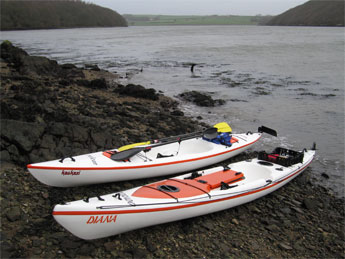Kaskazi Pelican

Length 15' 7" (4.75 m), Width 24.5" (62 cm), Weight 51 lbs (23 kg).
Maximum weight capacity 397 lbs (180 kg) depending on water conditions.
It was early December when my wife took the call from Simon of Kaskazi UK, the reason for my wife taking the call was that we had just returned from a Christmas party and it being the first of the season I was less than fit to hold a conversation with anyone, but being the good wife, she quickly handed me the phone and sat back and smiled, well I think it was a smile!
After a very brief conversation, it was agreed that Simon would call me early in the morning before coming round to pick me up and heading for the South Coast to do a little fishing.
Thankfully the phone was slow to ring the following morning and a good nights sleep was had, I awoke only slightly worse for wear.
Simon was soon stood on the doorstep, his roof rack loaded with a Dorado and his new arrival the Pelican, both hand built in South Africa. With the forecast predicting a wet and windy afternoon and with my rather weak constitution we decided that it would be for the better if we just went for a paddle, giving me the opportunity to be the first to paddle the Pelican on UK waters.
As with all sports there are those people that want or demand the very best equipment, fishing with the ultimate rod or reel, others just wanting to be different, owning tackle not readily available in the UK, kayak fishing is no different. Whilst the majority are happy to fish from a polyethylene sit-on-top kayak, there are those that are looking for the ultimate ride, the ultimate in some eyes being a composite kayak, both light and fast. Speed and lightweight doesn't come cheap, does it? At under £1000 the Kaskazi Pelican might raise a few eyebrows and gain a few friends.
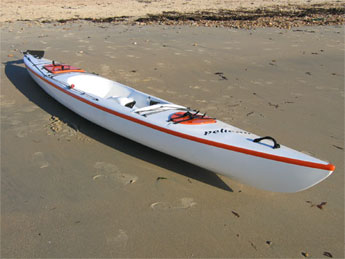
The sit-on-top Pelican is the latest Kaskazi Kayaks model to hit the UK shores, designed as a sea tourer, but with stability close to that of her sister the Dorado, the Pelican is perfect for those that prefer the uncluttered approach to fishing such as the saltwater fly fisherman or woman.
The Pelican is hand built in South Africa, using a fibreglass sandwich construction. All materials are carefully weighed during production to help maintain the brochure specified weight which is a very pleasing 23 kg, compare this to the average weight of a polyethylene sit-on-top at 28 kg and you start to see the attraction of a composite kayak.
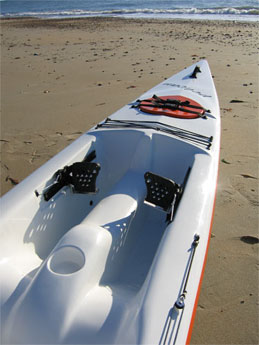
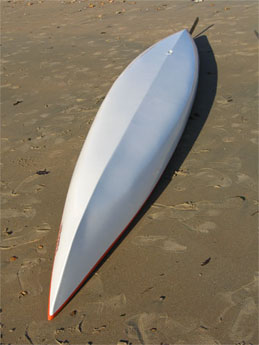
Standard fittings are what you would expect from a quality brand of kayak, bow and stern carry handles, deck rigging, elasticised cord to the front of the cockpit for attaching accessories such as deck bags or simply to hook the paddle blade under as you make another cast.
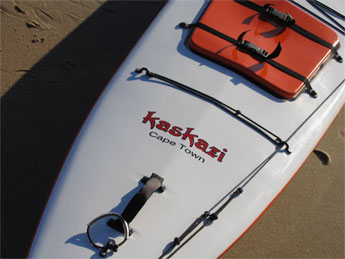
A recess forward and aft of the cockpit is for the fitting of an outrigger, the forward recess accommodating a hole for fitting the Kaskazi's 1.6m2 Delta Swivelrig, a tuneable sail which doubles as a sun shade for those hot summer days. Two hatches one each forward and aft with fibreglass lids, each secured with adjustable straps, lead to the two bulkheads, an added safety feature should the kayak accidentally become flooded and providing adequate storage for a camping adventure. Finally a three piece aluminium rudder with pedal controls.
For the UK market, the Pelican has a Venturi self bailer system fitted in the footwell of the cockpit, the Venturi system is designed to suck water from the footwell and disperse it via a small outlet in the base of the hull which is situated just behind the cockpit.
The Pelican is undoubtedly a pretty kayak and provoked a lot of interest from passers by, many stopping to get a better look and gesticulating to their fellow walkers.
Climbing aboard required a little thought, unlike my own kayak the Pelican requires you to drop into the deep contoured seat rather different to my accustomed slide across the gunwale. Forward of the spacious seat is a raised centre console with cup holder, useful for small bits of tackle, the bevelled console ideal for attaching a forward rod holder if required.
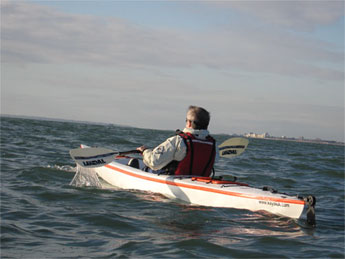
Once settled I headed out over the minor shore break, riding cleanly over the swell rather than through it, the added buoyancy in the design aiding a remarkably dry ride through the white stuff.
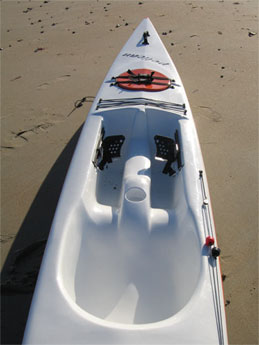
With its 62 cm beam the Pelican is a little twitchier than the Dorado, but at no time does she give a feeling of instability. Once past the shore break it was time to lower the rudder via a control line and toggle on the starboard side of the cockpit, the toggle is level with your body and needed considerable effort to get the rudder in the required position, I suspect the problem was due to this being the Pelican's first outing, as the system is the same used on the Dorado which I had paddled in the summer, the Dorado's rudder worked with ease. The toggles on the Pelican's system however were positioned badly, my right knuckle striking them annoyingly on every stroke, this could easily be remedied by a slight adjustment to the rigging; taller paddlers may not suffer the same problem.
The rudder is excellent, a small rocking movement on either of the fully adjustable foot pedals and she turns effortlessly, making downwind work, running with the swell very comfortable indeed, a small foot movement is all that is needed to keep you on track. Should you forget to lift the rudder when beaching, it simply lifts and drags, if however extreme pressure is applied to the aluminium rudder blade it is designed to bend or break thus avoiding damage to the hull or rudder mechanism.
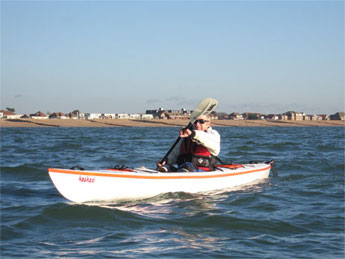
The Pelican makes light work of upwind paddling, the rudder in the raised position providing less drag and her 'easy to paddle' efficient design makes a normally tiring direction less of an ordeal, the buoyancy in the bow again helping the bow glide over the swell, making for a dryer ride.
When you spend several hours at sea in a kayak, your personal comfort is important, the Pelican's deep moulded seat and large cockpit give a comfortable and well supported ride, with ample room for even the largest of paddlers.

Unlike the Dorado the standard Pelican is not fitted out for fishing, but with a few easily added essentials, namely an anchor trolley system, a deck bag for tackle storage and maybe a rod holder, the Pelican will make an excellent platform to fish from, ideally suited to fishing the fly or lure, if you prefer to bait fish or target larger species then I would advise a look at the fishing ready Kaskazi Dorado.
